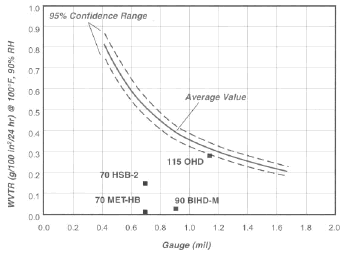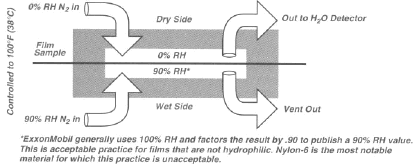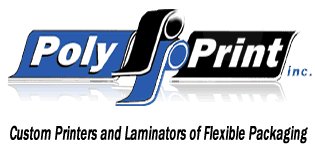Water Vapor Transmission Rate
Definition
Relevance to package performance
What affectsthe WVTR of OPP films
Test principles
Related Terminology
Definition
WVTR (water vapor transmission rate) is the steady state rate at which water vapor permeates through a film at specified conditions of temperature and relative humidity. Values are expressed in g/100 in2/24 hr in US standard units and g/m2/24 hr in metric (or SI) units. Test conditions vary, but ExxonMobil has standardized to 100°F (37.8°C) and 90% RH, which is the most common set of conditions reported in North America.
Relevance to package performance
A critical function of flexible packaging is to keep dry products dry (potato chips, pretzels, fortune cookies...) and moist products moist (cheese, muffins, chewing gum...). Without protective packaging, products will quickly gain or lose moisture until they are at equilibrium with the environmental relative humidity. At this point, crispy products are soggy, and chewy products are hard and dry.
WVTR is the standard measurement by which films are compared for their ability to resist moisture transmission. Lower values indicate better moisture protection. Only values reported at the same temperature and humidity can be compared, because transmission rates are affected by both of these parameters.
One of the most valued properties of OPP is its exceptional moisture barrier. As shown in Table 9, gauge for gauge, OPP provides the best WVTR of all common polymer packaging films. (For homogeneous films like these, you can calculate the WVTR for a particular thickness by dividing the values in the table by the desired gauge in mils.)
Film Type |
WVTR @ 100°F (38°C), 90% RH for 1 mil film |
|
|---|---|---|
| (g/100 in2/24 hr) | (g/m2/24 hr) | |
| Biax OPP | 0.25 - 0.40 | 3.9 - 6.2 |
| HPDE (high density polyethylene) | 0.3 - 0.5 | 4.7 - 7.8 |
| Cast PP | 0.6 - 0.7 | 9.3 - 11 |
| Biax PET (oriented polyester) | 1.0 - 1.3 | 16 - 20 |
| LDPE (low density polyethylene) | 1.0 - 1.5 | 16 - 23 |
| EVOH* (ethylene vinyl alcohol) | 1.4 - 8.0 | 22 - 124 |
| Table 9: Normalized WVTR values for common films | ||
| *Dependent on ethylene content of the particular grade. | ||
CAUTION: In order for film moisture barrier to contribute its full product protection value, package seal integrity must be satisfactory. Poor quality seals can negate a film's good barrier by allowing vapor transmission through channel leakers and imperfections.
Within the arena of OPP films, tensiles are generally not critical and rarely require discussion and specification between supplier and customer. This is so because oriented polypropylenes provide a dependable range of tensile values. Other properties are usually more important to successful performance. There are two notable exceptions worthy of explanation.
- Orientation method: blown or tentered
The orientation method causes characteristic differences in tensile properties. Blown films are "balanced," having similar strength and elongation in the machine and transverse film directions. Tentered films (as are all ExxonMobil films) have higher strength and lower elongation in the transverse direction than in the machine direction. Most OPP manufacturers produce tenter-oriented films, which work well in many diverse applications. - Modulus and web tension
Modulus, because it is a measure of strength characteristics in the film's elastic region, provides valuable insight into stiffness and how extensible the film is under normal use tensions. When comparing two films of identical thickness, the one with a higher modulus will be stiffer and stretch less under the same tension force.
NOTE: High temperature modulus testing and empirical trials on converting equipment have yielded an industry rule of thumb: OPP web tensions should be controlled to .50lbf per inch of film width, or less, for good registration and no permanent deformation (elongation, neck-in, gauge bands). From a filmmaker's perspective, the lowest controllable web tension is best. Thinner films and higher converting temperatures make this more critical.
What affects the WVTR of OPP films
The most obvious factor that impacts WVTR is thickness: if an OPP of the same product design is twice as thick as another, its WVTR will be half the value. This is so because WVTR is an inherent, bulk film property of OPP.
It is common to find variation in the reported WVTR values for same-gauge OPP films produced or measured by different manufacturers. The primary factors causing these differences are:
- Raw material: Homopolymer PP resin differences in average molecular chain length, range of chain lengths, and degree of crystallinity can account for up to a 10% difference in WVTR. Additives and copolymer resin layers can account for differences of up to 30%.
- Process: Normal differences in process conditions between one orienter and another account for about 5% variation in WVTR values. (WVTR is reduced through orientation, because the crystalline regions of the polymer matrix are aligned. In other words, orientation efficiently "packs" polymer chains, so that larger spaces are minimized. Process conditions affect this "packing," and therefore, WVTR values.)
- Measurement: The instrument manufacturer, MOCON®,states a test precision of :t3% with their PERMATRON-W® product line. Therefore, trained operators using this type of instrumentation will generate values from .34 to .36 when testing a 1 mil OPP with a nominal WVTR of .35 g/100 in2/24 hr.
ExxonMobil performed WVTR testing on a wide range of coex (plain, uncoated) products and gauges produced on different orientation lines. Graph 2 plots the average WVTR as a function of gauge and shows the 95% confidence range that embodies variation from the factors described previously. (This only involves ExxonMobil coex films. The confidence limits would be wider if other manufacturer's films were included in the data, because there would be more material and process variation.)
 |
| Graph 2: Plain OPP WVTR as a function of thickness |
| The inherently good moisture barrier of OPP can be further enhanced by additives, coatings, or metallization. ExxonMobil produces high barrier PVdC-coated and metallized films that dramatically improve the WVTR of OPP and Hicor films. The values for four of these products, HBS-2, MET-HB, Hicor OHD, and Hicor BIHD-M, are plotted in Graph 2. |
Test principles
ExxonMobil uses MOCON Permatran W® instruments for measuring WVTR. The instrument design and the way we operate the instrument is consistent with ASTM F 1249. ExxonMobil standardizes its reporting to test conditions of 100°F (38°C) and 90% RH. Conceptually, a test cell looks like Figure 3. Dry nitrogen gas is swept through a chamber where the test film acts as the membrane separating this dry gas stream from a "wet" nitrogen stream on the other side. The partial pressure difference creates a driving force for the water vapor to permeate through the film to the low pressure side. The barrier of the film determines how much water vapor can transfer, and this is continuously measured by an infrared detector in the outgoing stream of the dry side.
 |
| Figure 3: Cross-section of a WVTR test cell |
The test is complete when equilibrium, or steady state, is achieved, which is when the infra-red sensor detects water molecules leaving the dry chamber at a constant rate. The amount of water vapor permeating through the sample per unit time period is not changing. This rate is the sample WVTR and is recorded in units of g-H2O/100 in2/24 hr at 100°F (37.8°C), 90% RH.
This overview describes how ExxonMobil measures WVTR and was based on articles and product literature provided by MOCON®. There is much more to the science of mass transfer and to the instrumentation that allows us to measure it. For more information, contact MOCON in Minneapolis, MN at (612) 493-6370, or visit http://www.mocon.com.
Related terminology
Normalized WVTR: Normalized WVTR is equal to the measured WVTR multiplied by the gauge of the sample in mils. In other words, it is the approximated WVTR of the material at 1 mil thick. We provided normalized WVTR values in the first table of this write-up in order to compare the inherent moisture barrier property of different classes of materials. This technique is only appropriate with homogeneous films and is not appropriate for coated or metallized films.

